The Begonia Maculata, also known as the Polka Dot Begonia, is a fantastic show-stopping plant. If you’ve seen one, you’ve already experienced the awe this plant brings because of its deep, lush green foliage contrasted with its bright polka-dot spots. In this article, read and learn how to care for a Begonia Maculata polka dot plant.
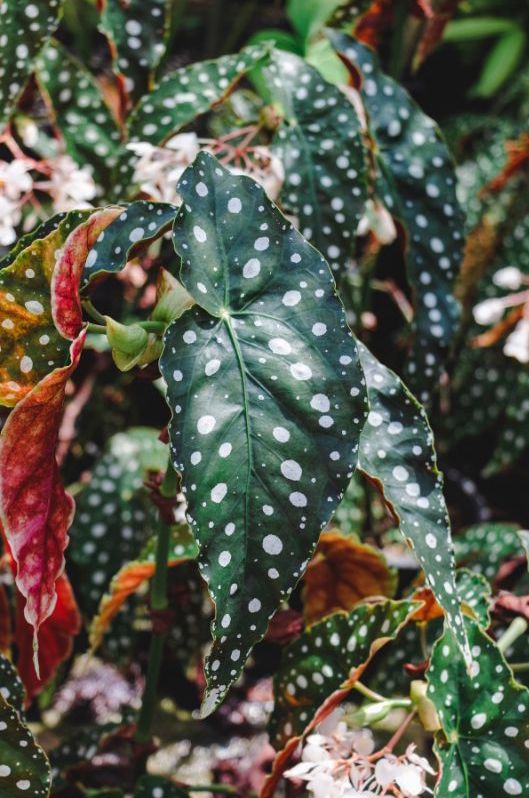
It is one plant where your eyes just seem to stare for too long just for how mesmerizing it looks! Due to this, most are intimidated to care for a Begonia Maculata. Unfortunately, this could not be farther from the truth!
If you’re looking to care for your first Polka Dot plant, then you’ve come to the right place! We’ll put in the spotlight the most important aspects of taking care of this plant. This includes their optimum growing conditions, steps to propagate and troubleshoot common problems, and clever ways to keep their captivating colors!
Now that’s out of the way, let’s delve into the nitty-gritty of taking this care for what might be your first Polka Dot plant!
Begonia Maculata Profile
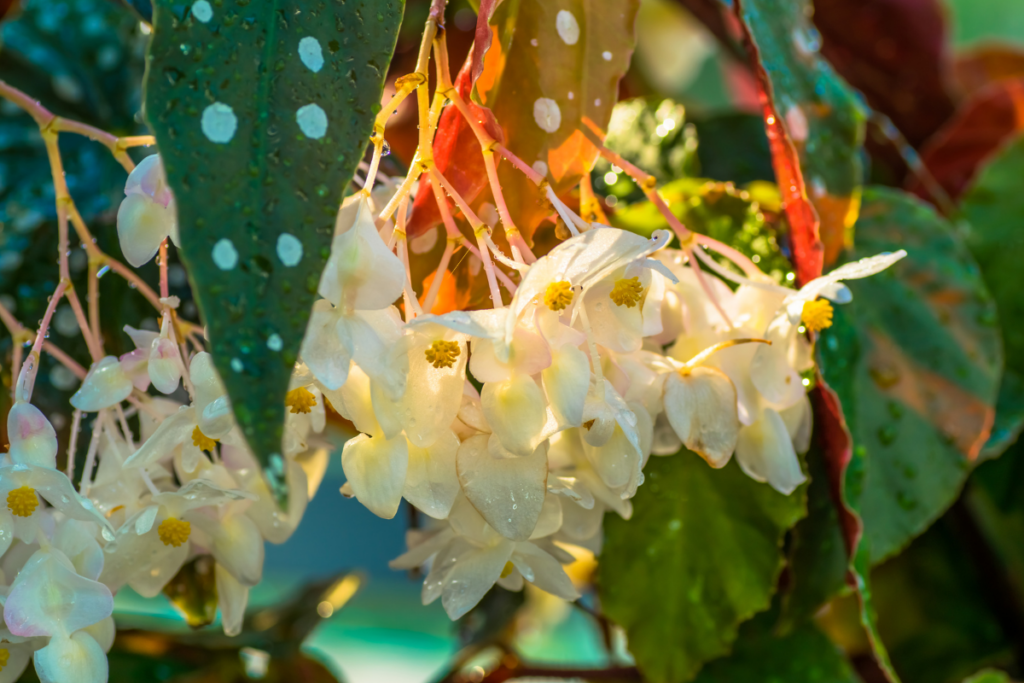
General Information
Begonia maculata’ Polka Dot’ is a trendy houseplant that is a cane begonia type. It is angel-winged and sometimes called the Wightii, Polka Dot Begonia, Trout Begonia, or the Clown Spotted Begonia. The plant has been in the market for some time, but it has only become popular recently.
The unusual, quirky look is the charm of this flowering plant. It has silver-colored polka dots embedded on olive leaves with crimson to burgundy undersides. Meanwhile, the flowers are bell-like and range from red to white, with vibrant yellow at the center. Indeed, this plant is very colorful and over-the-top.
The Begonia plants originated from the tropical forests of Brazil. They thrive best in tropical climates.
Etymology
The genus Begonia was named after Michel Begon, a governor of the French colony of Saint-Domingue, which is now Haiti. It is coined by a French botany patron, Charles Plumier.
On the other hand, the specific epithet maculata comes from the Latin word maculatus, which means spotted, patchy, or irregularly blotched. This refers to the leaf markings that look like painted polka dots.
Flowering
Aside from its already astonishing leaves, the Polka Dot Begonia maculata has simple yet elegant flowers that bloom from spring through autumn. It produces clusters with white petals and bright yellow centers on single stems. They serve as accents that elevate the already spectacular display of the Polka Dot plant leaves.
Season of Interest and Purchasing
This plant grows actively during the spring and summer. Hence, you may want to purchase this plant during those times so you can supplement it with the right food and requirements.
Growth
Begonia maculata is considered a quick grower if given the right growth conditions. The plant typically grows to a height of 20 to 40 inches and a spread of 4 to 20 inches.
Begonia Maculata Polka Dot Overview
| Scientific name | Begonia maculata |
| Common name/s | Polka Dot Begonia, Trout Begonia, Spotted Begonia, Clown Spotted Begonia |
| Family | Begoniaceae |
| Growth Habit | Herbaceous |
| Height and Spread | Height can reach 20-40 inches, spread can reach about 4-20 inches. |
| Classification based on life cycle | Perennial |
| Origin and Distribution | Originates from Brazil |
| Climate Zone | Generally mild climate |
| USDA Plant Hardiness Zone | USDA Zone 10-11 |
| Color | silver-colored polka dots embedded on olive leaves that have crimson to burgundy undersides |
Care Tips
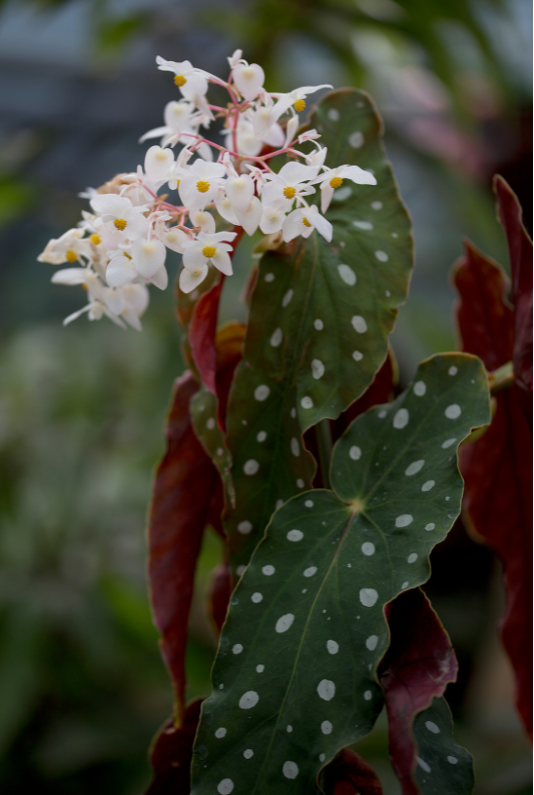
Light Requirement
This plant isn’t too nitpicky with its sunlight as long as you do not expose it to bright, direct, and scorching sunlight. Instead, it will happily thrive in bright, indirect light and lower light levels. This makes it ideal if you would like to have a gorgeous plant at a certain spot in your home that doesn’t receive too much light.
However, do keep in mind that it still needs some sunlight and will not be happy if you keep it at dimmer light levels.
Keep this plant away from direct light as this will burn the Begonia Maculata’s leaves. Not only that, but it will also fade away its silver spots. You’ll know when your Polka Dot plant is not receiving enough light when it loses some color, turn yellow, and finally sheds off.
Temperature Requirement
If you keep your plants indoors, then keeping their temperature cozy shouldn’t be a problem. The temperatures they thrive in are also the same temperatures we like, which are usually between 65°F (18°C) to 86°F (30°C).
Do take note that they do not like too drafty spaces. Avoid temperatures below 59°F (15°C). If you’re in a colder climate, don’t wait until the first signs of frost before you bring your plant inside.
Water Requirement
As compared to light, the Begonia Maculata’s water requirement might be trickier. This plant mostly likes moist soil, meaning a regular watering schedule is recommended.
However, it is also essential to make sure that the top half-inch of its soil dries out before watering it. Allowing topsoil to dry first prevents root rot first and foremost. Aside from this, it also deters nuisance pests and diseases such as fungus gnats and fungus.
Depending on the season, you can water every four days in the summer to every 1-2 weeks in the winter. First, feel for the first half-inch of the soil. If it still feels moist, wait for 1-3 days and check again. If it is dry, then you can water the plant.
Humidity Requirement
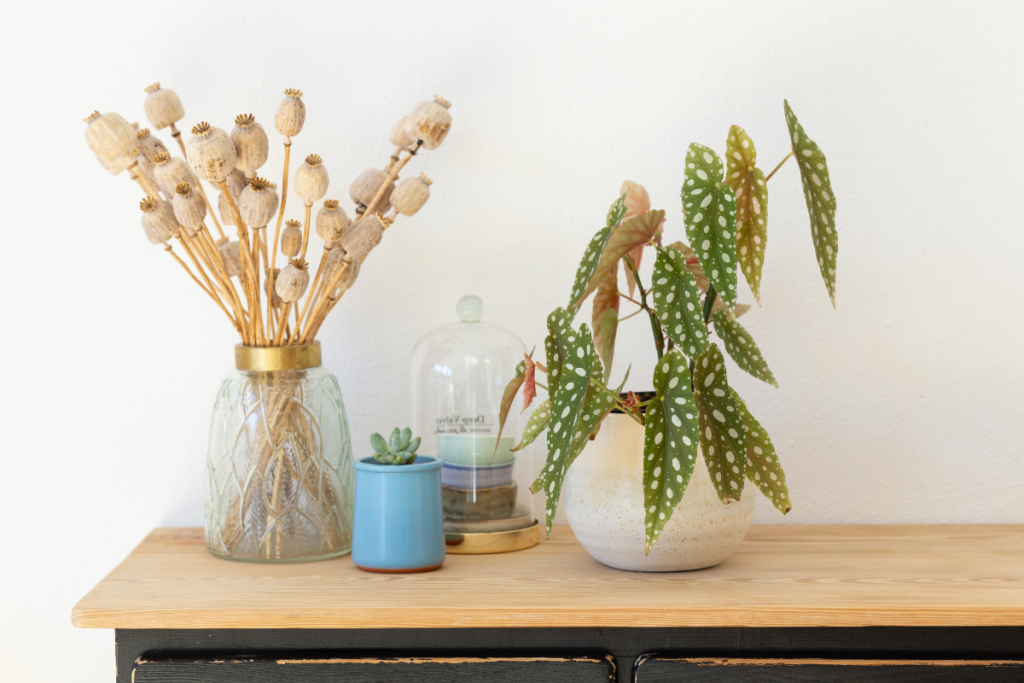
For these Polka Dot Begonias, average home humidity is usually enough. However, it will grow best in a humid environment, so putting it in a room with a bit more humidity is best. A humidity of at least 45% works but the higher humidity, the better.
You may need to provide an extra humidity boost during the dry winter months. It can be helped by misting it frequently, placing it near a humidifier, or using a pebble tray.
Soil Requirement
The soil should accommodate for this plant’s needs and preferences. As you may have guessed, this plant particularly likes soil that holds moisture well without drowning in water. They thrive well in light, good quality pre-mixed soil blends but mixing your own soil allows for granular control.
We recommend using a mixture of perlite, woodchips, and a little bit of compost or inorganic fertilizer. Perlite does an amazing job of keeping your soil well aerated and lightweight. Additionally, they keep the soil well insulated, preventing sudden temperature changes.
Wood chips also aid aeration and provide a medium to which the Begonia Maculata can hold on to. Finally, the light sprinkling of compost boosts the fertility of the medium. Mix these three with a light commercial potting soil, and you’ve got a perfect mix for your Polka Dot plant!
Fertilizer Requirement
Speaking of fertilizing, this probably is the easiest part of taking care of your Begonia. Since your plant flowers, it will require fertilizer every now and then to sustain its energy and nutrient requirements. A guideline is to add liquid fertilizer to water every other instance you water your Begonia. Essentially, this will fertilize the plant every other week.
It is important to note to only fertilize during the growing season, from spring to summer. When autumn and winter come, it starts going into dormancy, and the excess nutrients will just burn its leaves at its tips and edges. No special mixes are needed. Just use a balanced, equal NPK number and dilute it to 50% of its concentration.
Space Requirement
Begonias can grow large and grow quickly. Therefore, you may need more space to cater to the needs of the plants. However, avoid putting this in an extremely large pot to prevent overwatering and rotting issues.
Growing And Planting Tips
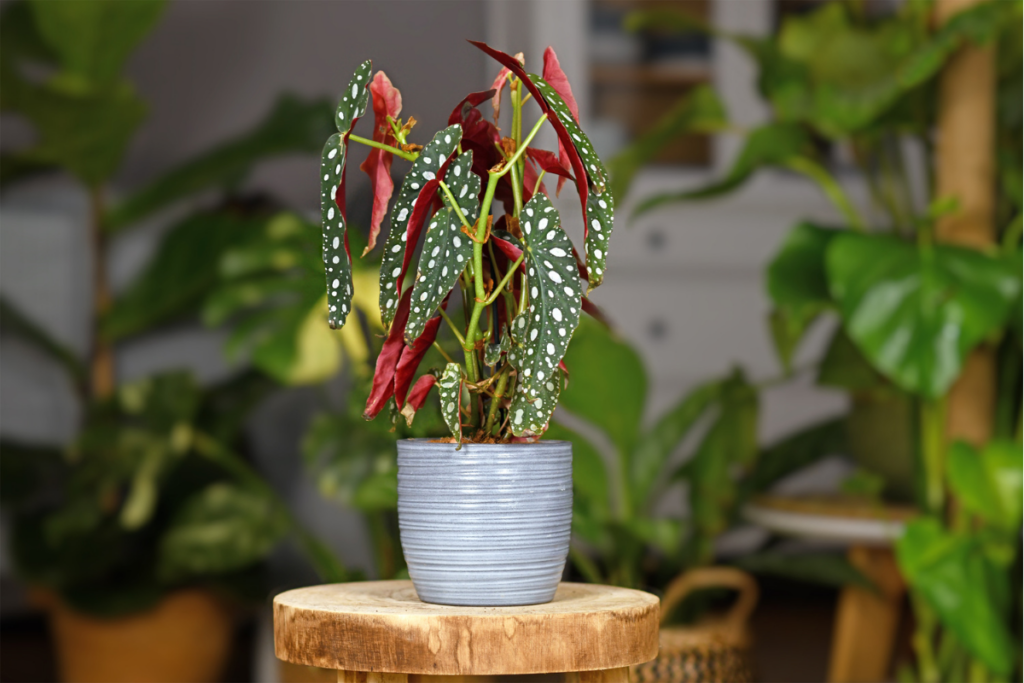
Propagation
Aside from the easy fertilizing and pruning of the Polka Dot plant is also the propagation! There are two ways you can go about this, and it is through water and soil propagation.
Water Propagation
Water propagation doesn’t get any easier. Simply take healthy stem cuttings from your established Begonia Maculata and take the cutting’s end into a jar of water. Then, put it in a small container as hormones are released for it to root in the water, and you don’t want to dilute this.
Soil Propagation
On the other hand, soil propagation involves dipping a cutting’s end in a root hormone powder and burying that end in its appropriate potting soil. Firm up the soil around the cutting and water sufficiently.
Once you’ve chosen a method, wrap the plant in a plastic enclosure, open it up every couple of days, and mist it. Give the cutting adequate light, keep its temperature stable, and your new plant will soon be established!
Pruning
This plant can overtake space in a relatively shorter period of time. This isn’t to say that it’s a bad thing, as even when it takes space, it’s still a sight to behold. However, some still prefer a prim and proper plant. This plant’s stems can become tall and lanky instead of growing out, and pruning will help fix this.
The minimal approach you can take to pruning is by cutting the tips. The cane’s tips release hormones that suppress branching. If you take this tip off the cane, it will stimulate branching and, therefore, a bushier growth. Cut about 1/4th of an inch above a leaf. A new leaf will soon sprout just below the cut. Do this over any portion of the plant you want so that you can direct its growth.
Take note to always sterilize any pruning instrument by dipping it in alcohol or a mix of water and bleach to disinfect them. This will help prevent the spread of pests and diseases.
Potting And Repotting
Rrepot your Begonia once every year or so. These plants usually like to be a little bit root bound, but this usually fatigues the soil too much to the point where the medium cannot appropriately support the plant. Even if you do not change its pots, it does do better with a fresher soil.
Since the tops of these plants can get quite hefty, a pot should be able to match that heftiness. A terracotta or stone pot should do just fine. If you repot in the same pot, loosen your plant’s root ball, so the roots are exposed to new and fresh soil.
If you do pick a new pot, make sure that the pot isn’t too big, as a bigger pot will dry out less quickly. This means that your plant can be more prone to root rot as it will sit longer in moisture.
Begonia Maculata Care
| Light | Bright indirect light |
| Temperature | Intermediate to warm, 65-86 degrees Fahrenheit |
| Water | Once a week, increased in summer, decreased in winter |
| Soil | Airy, well-draining soil; pH of 6.6 – 7.3 |
| Fertilization | Regular household fertilizer, once to twice a month |
| Space | Generally medium to large space required |
| Propagation | Via water and soil propagation |
| Blooming | Enough sunlight and maturity needed, spring to fall |
| Pruning | Regular pruning to keep compact growth |
| Potting | Regular potting mix, use of perlite and wood chips recommended |
Problems And Troubleshooting
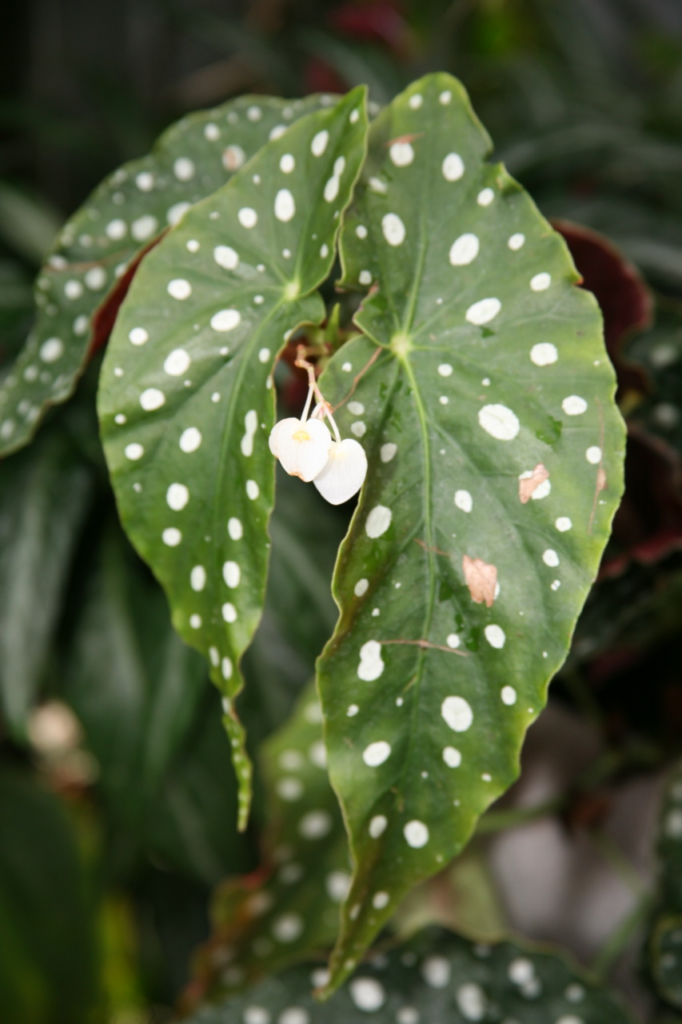
Overwatering
The proper combination of moist and dry soil is ideal for your Polka Dot Begonia. They don’t like being completely dry, and they also don’t like being overwatered.
Always check the soil. Allow the soil to dry up before watering again totally. Overwatering can result in yellowing foliage, fungal diseases, root rot, and fungus gnat problems. Prevention is better than cure.
Underwatering
Your Begonia maculata Polka Dot will suffer if they go too long without water. Brown and crispy leaf margins are common signs of underwatering.
On the other hand, these plants are drought-tolerant, preferring to be submerged rather than overwatered. If your plant is suffering from underwatering, give it some moisture immediately. They will eventually recover.
YellowLeaves
By far, the most common cause of yellowing leaves is overwatering. Other factors that may cause this are low light or too much sun or bright light, sudden chills, disease, infestation, or under fertilization. Brown spots may also develop when edges burn due to heat, direct sun, or chemical burns.
Dropping Leaves
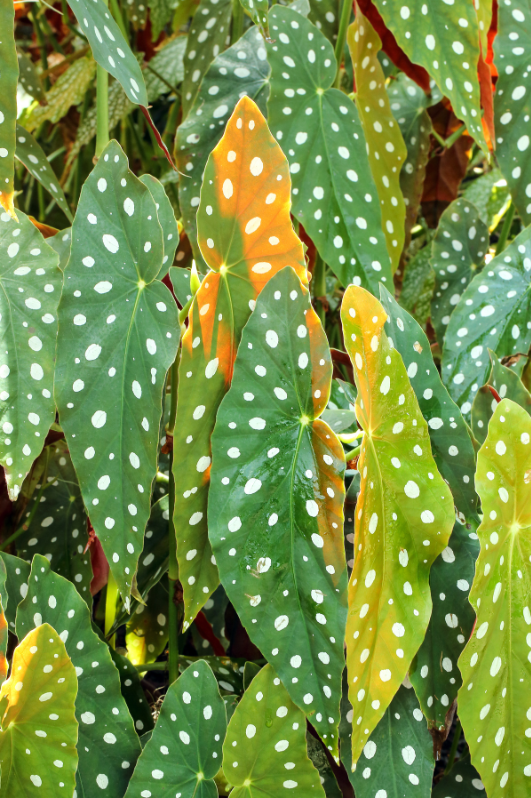
Most often, Begonia maculata dropping leaves are caused by insufficient moisture and humidity going around. The air in your room or in your space may be too stagnant as well, or it isn’t clean enough (which should not be the case in the first place).
Heavy soils can also stress out your plant. If all treatment fails to address this issue, you can always try moving the plant to a brighter spot.
Nutrient Deficiency
Any essential nutrient deficiency can cause harm, and in the worst-case situation, it will cause death. It can also cause leaf color loss. To minimize issues caused by nutrient insufficiency, be sure to give your plant enough light, a frequent watering schedule, and feed it with a well-balanced fertilizer.
Flowering Problems
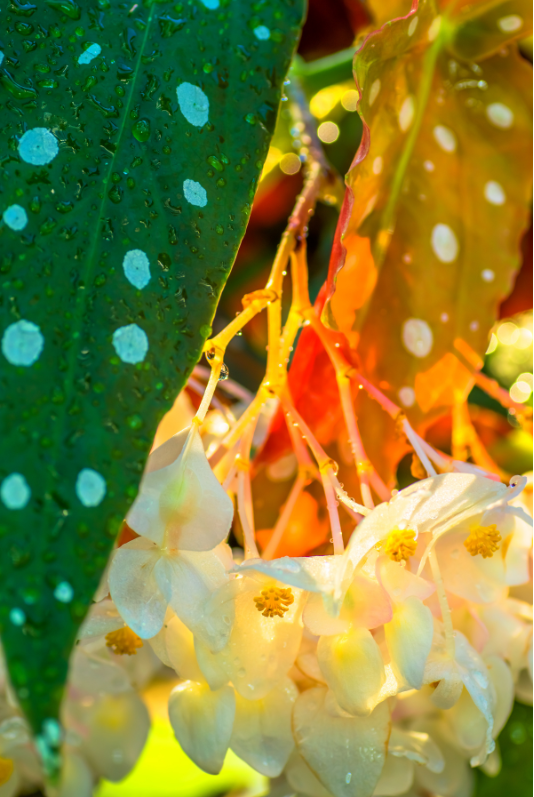
These plants will not blossom indoors unless there is enough light. Therefore, it’s likely to bloom outside. Begonias will blossom during the growing season if the conditions are favorable.
If you correctly fertilize your plant, then it should give you an incredible bloom. However, its flowers don’t last. To make it last longer, you can prune flowers that have already bloomed. This will help the plant grow more fresh-looking flowers throughout its growing season. If you do not desire this accent, you can decrease your plant’s fertilizing frequency to just once a month.
Pests
Spider Mites And Scales
The most common pests of Begonias are spider mites and scales. They suck the sap of your plant and can cause damage. Mites may be harder to spot while scales are more visible. Once you spot these pests, you can spray them with the insecticidal soap of your choice. This might take 3 to 4 weeks to resolve. Another option is neem oil.
Mealybugs And Whiteflies
These sap-sucking vampires usually will colonize the underside of your plant’s foliage. So part of your routine checkup should include checking the underside of your plant’s leaves. Whiteflies will specifically scatter around once their habitat is disturbed. To treat this, apply insecticidal soap to your leaf’s underside.
Another method is to apply an organic pesticide like neem oil or release a natural predator like ladybugs to eat up these pests.
Diseases
Powdery Mildew
This is the most common disease that this plant will encounter. It is a fungal disease that afflicts Begonias in more humid conditions. It starts as a white circular spot with a powder-like texture over the leave’s foliage. To treat this, remove affected leaves and stems and treat all leaves with a fungicide. Still, prevention is best. Maintain adequate air circulation and always let the topsoil dry before watering.
Botrytis
Another fungal disease that takes hold on leaves that touches the soil. It looks like wet brown patches on your plant’s foliage. Poor air circulation can also contribute to this. To treat, remove afflicted leaves and blooms. If it returns, apply fungicide to affected areas.
Begoni Maculata Pests And Diseases
| Common Pests/Diseases | Symptoms | Treatment And Prevention |
Common diseases include crown rot, stem rot, root rot, leaf spot, fungal diseases, and Botrytis infection | Yellowish rimming around black or dark brown spots on leaves | Avoid overwatering. Keep soil dry. Avoid too high humidity.Proper ventilation is needed around the plant. Remove infected parts of fungal infections to avoid spreading |
Common pests include mealybugs, spider mites, aphids, and scales | Visible insects on the surface | Spray plant with warm, soapy water. If infestation is present, use insecticide or neem oil. Use diatomaceous earth. |
Problems With People And Animals
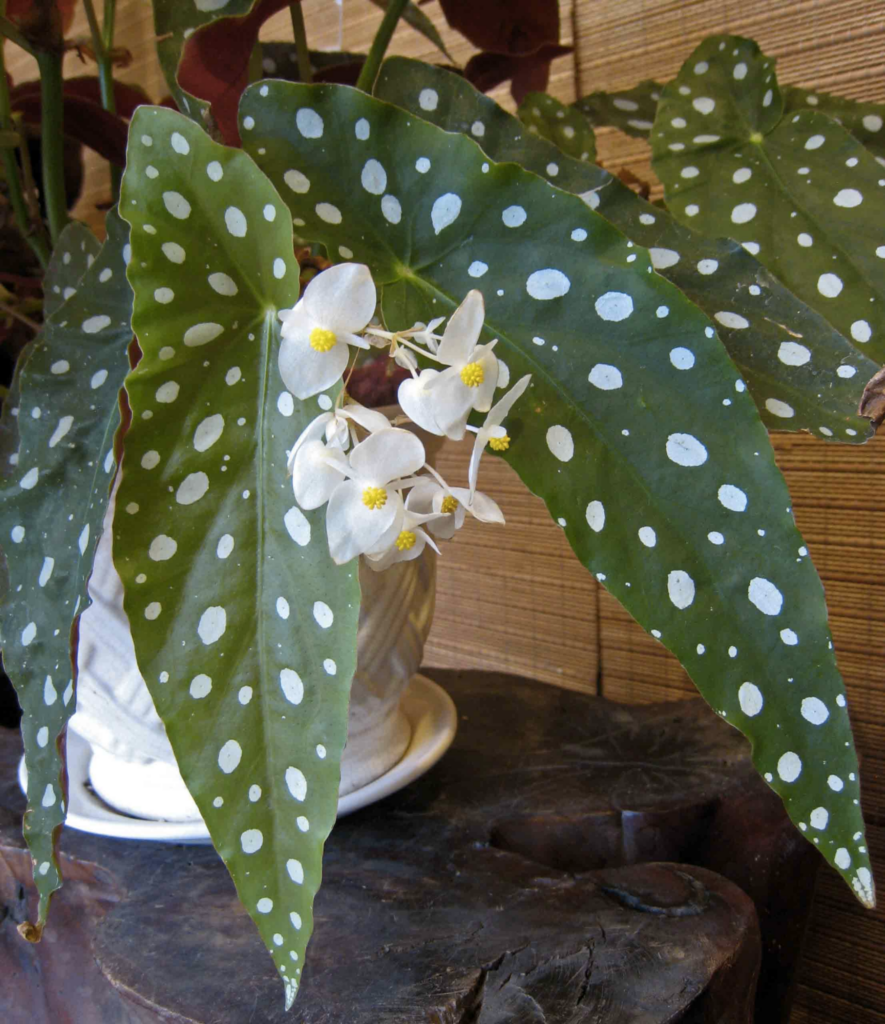
Toxicity
If you have pets or children around the house, you can rest easier knowing that this plant is known to be non-toxic. However, it is still important to keep this away from pets such as dogs, cats, and horses, and from small children. This is because their leaves and stems do still cause light irritation to the throat and vomiting. It’s still not as harmful compared to another house plant, though.
Begonia Plants Meaning And Symbolism
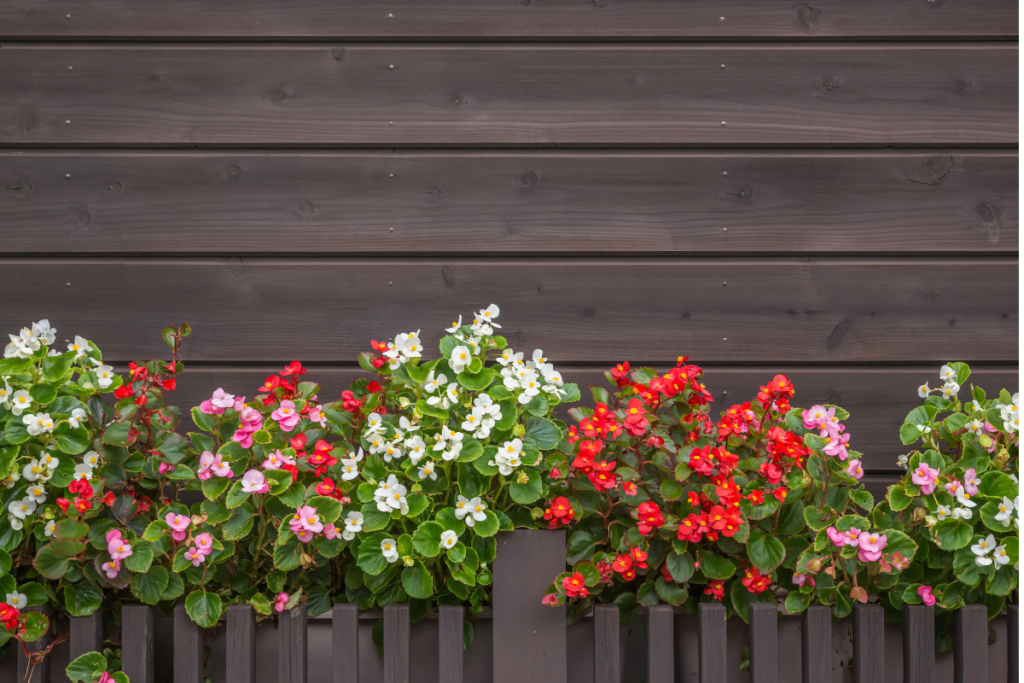
The Begonia flowers have many meanings, depending on the color of the flower. Traditionally, they symbolize harmony, gratitude, uniqueness, and caution.
Different colors have different meanings. For example, red begonias mean love, romance, and passion. Pink begonias also symbolize love and romance, however not as intense as the red ones. On the other hand, yellow begonias mean happiness, wealth, and joy, while white ones mean innocence and purity.
Begonia Aaculata Symbolism And Meaning
| General Meaning | Harmony, gratitude, uniqueness, caution |
| Symbolism | Red – love, passion, romance Pink – love, romance (less intense than red) Yellow – happiness, wealth, joy White – innocence, purity |
Landscaping And Gardening Ideas
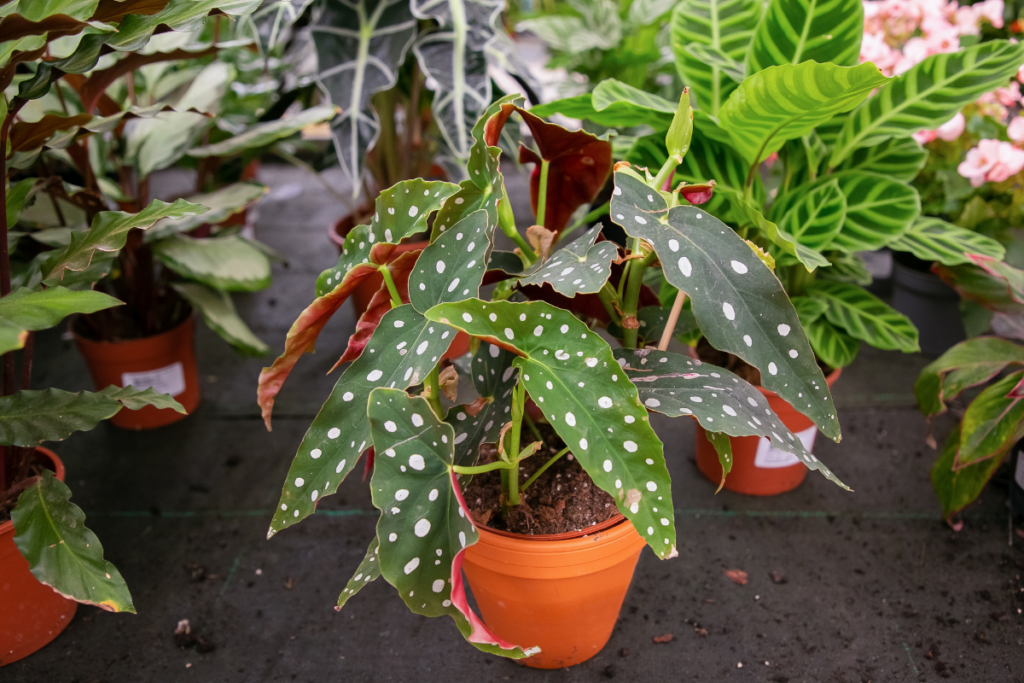
Companion Plants
Begonias are excellent companions to other plants because of their gorgeous leaves and magnificent blooms. It goes well with other tropical plants such as Dracaenas, Gingers, Coleus, and Caladiums.
Caladiums are often used to brighten up the surroundings of Begonias. Gingers and Dracaenas grow the same height as Begonias and thus are good companions to provide height in your garden. Coleus provides extra tropical flair to your garden space.
Landscaping Ideas
Begonias are great focal points for your gardens due to their tall stature and vibrant colors. They provide height and thus can be planted as border plants at the back of some smaller plants. They will surely be an excellent background to your gardens.
| What to plant with | Caladiums, Dracaenas, Coleus and other tropical plants |
| What NOT to plant with | Basically nothing |
Conclusion
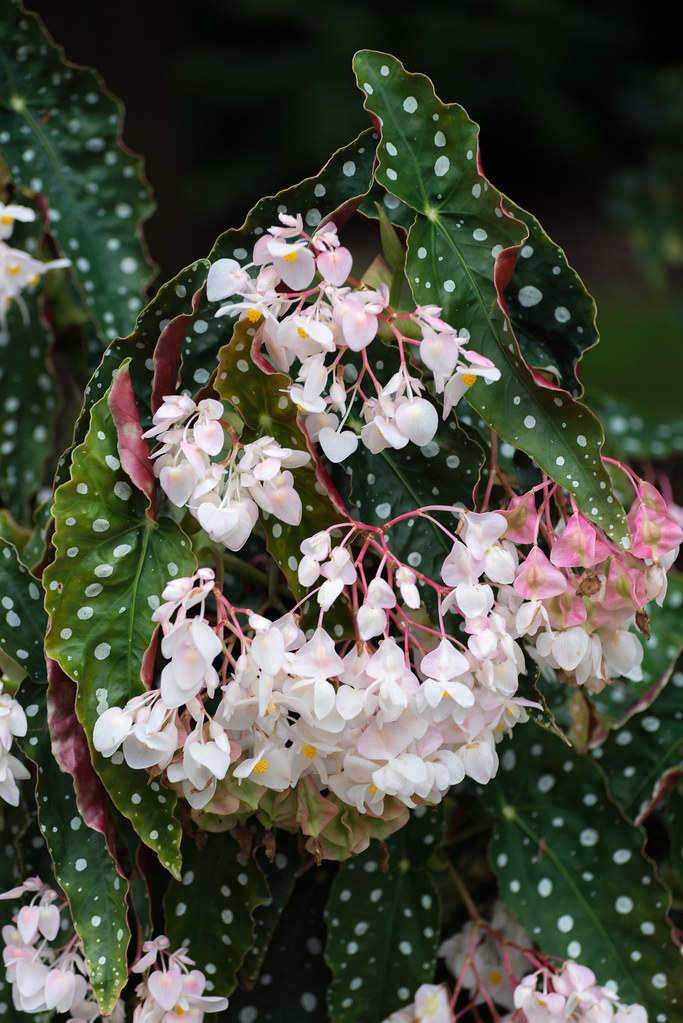
As you can see, the Begonia Maculata care is one of the easiest that you can do. It does not demand too much attention from you aside from the water schedule, the occasional fertilization, and then pruning every once in a while.
Despite this, it still gives back a lot with its stunning display of foliage and a dainty yet elegant flower to accentuate and elevate the beauty of this plant.
Treat it well, and it will treat you better in return. Get ready to have an entourage of guests ogling this plant all day long!
Frequently Asked Questions
Is Begonia maculata toxic?
No, your Polka Dot Begonia is not a toxic houseplant. But it is best to keep it away from pets and small kids because it can still cause mild irritation and vomiting when ingested.
How big do Begonias get?
With the right growing conditions, your Begonia maculata can grow up to 20 to 40 inches in height, and have a spread of about 4 to 20 inches.
Is Begonia maculata a rare plant?
The Begonia maculata Polka Dot is a rare plant. Although, with the advent of tissue culture cultivation and mass propagation, the plant’s availability in the market has improved.
Is Begonia maculata hard to care for?
Definitely not. Begonias are relatively easy to grow and care for. They can thrive in a suitable room condition provided that the optimum care and attention are given. Beginners can grow this plant.
How do I get my Begonias to flower?
In order for your plant to bloom, it must receive enough light. This is because the genes responsible for flowering are light-activated; hence, when light is insufficient, these genes will not be activated and will not induce your plant to flower.
Editor’s Recommendations
20 Types of Calathea Plants that You Should Have in Your Garden
Alocasia Zebrina: The #1 Care, Propagation, and Watering Guide
Philodendron Splendid: The Fail-Proof Care, Propagation, and Watering Guide You Need







